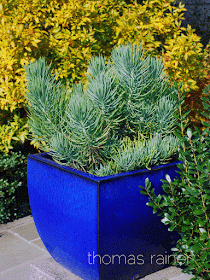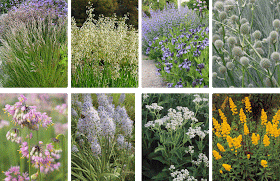How an Annual Snob became an Annual Obsessive
I’ll admit it: I was an annual snob. I really wanted a T-shirt that said, “Friends don’t let friends plant annuals.” For me, annuals meant overused bedding plants: red begonias plopped in front of the Wendy’s sign; straggly petunias past their prime in a hanging basket; or squatty little orange marigolds that never blended with anything else. Plus, annuals are simply impractical. Why spend money on an annual you’d have to throw away in the fall when you could plant a perennial?

Plus, there was something just downright tacky to me about annuals. They are loud, over-the-top, and always stick out in a crowd—kind of like that redneck cousin who drinks too much at family reunions. Perennials, on the other hand, were more refined. I spent the better part of a decade mentoring under the late perennial genius Wolfgang Oehme. I understood the medium. Perennials are a thinking man’s plant. I loved the cerebral challenge of arranging perennials. They constantly change. Arranging a border requires the mental acumen of a chess master. Leave the annuals to the fast-food chains and gas stations; perennials were my game.
But something’s happening to me now. No, I have not stopped adoring perennials, but I am increasingly captivated by annuals, tropicals, and bulbs. It first started when I was tasked with designing a raised median in downtown D.C. The client wanted a seven-foot wide median to be a beacon of color. It had to be beautiful in every season; stand out among the busy downtown environment; and never have a down moment. Gulp. I quickly sped through my shortlist of long-lived perennials. Nope. Long blooming shrubs? Nope. It would have to be annuals.
 |
| Median with boughs and stems in winter |
We ultimately decided to combine annuals and bulbs with sculptural shrubs such as columnar hollies and cloud-like hedges of boxwoods. Designing four seasons of spectacle—including the dead of winter—proved to be a one of my toughest horticultural challenges. At first, I was reluctant to use bedding annuals at all. We specified an elaborate mix of rare tropicals, designer annuals, and shrubs with colored foliage. I was rather pleased with the cutting-edge selections I made until I found out that the contractor could not find most of the plants. Not to cover a median that stretched three blocks. Last second substitutions meant dealing with what local annual nurseries had available: lots of pansies, lots of mums, lots of vinca. I remember being horrified with the first season rotation was almost nothing but yellow pansies and blue mums.
But the bedding annuals looked good, particularly at 45 miles per hour. From then on, we figured out how to use a base of bedding annuals and interplant more interesting combinations of tropicals, bulbs, and even shrubs used as annuals. The bedding plants provided the impact, and the accents provided the designer look.
 |
| Janet Draper's fabulous Ripley Garden |
Of course, through my horticultural journeys, several great plantsmen have tempted me with the dark and seductive world of annuals. Janet Draper’s Ripley garden at the Smithsonian Institute always featured fabulous exotic selections like the purple-spiked silvery leaves of Solanum quitoense or the inspired combination of Golden Shrimp Plant (
Pachystachys lutea), the deadly Firestick Plant (
Euphorbia tirucalli), and
Yucca ‘Hinvargas’. And there is Dan Benarcik’s mind-blowing combinations of tropicals and annuals at Chanticleer. And of course,
Nancy Ondra’s blog was another inspiration. Every time I see one of her combinations of annuals and perennials, I immediately go out and drop $20 on some mail order seed catalogue. Finally, there’s the Long Border at Great Dixter. I’m obsessed by what Fergus Garrett is able to do in that strip. So much horticultural expertise goes into such a concentrated space. Is it over the top and gaudy? Perhaps, yes. A hot blooming mess? Definitely. But it is one of the most brilliant stretches of planting anywhere on the planet, and I am forever haunted by what they are able to do.
My final turning point to the dark path of annual obsession was my own experiment doing a perennial border. After smothering a large area of lawn for six months, I was so tired of looking at mulch and cardboard that my wife and I filled the area with a bunch of aggressive “filler” perennials. That did the trick. It was an instant garden, but the border immediately became one big hazy blob of green. And that’s what I call it now. It’s not the border, but the big-hazy-blob-of-green (BHBOG). Last year, I tried to cut the garden with some “structural” perennials—perennials with more distinctive silhouettes—but they had a hard time establishing in the BHBOG. The BHBOG is hungry and it eats everything you plant in it.
So I’ve had it. Next spring, I’m ruthlessly hacking into the BHBOG. No more mild-mannered perennials. I want over-the-top, shocking color. Ridiculous color. Burn your retinas color. I don’t care what it takes, but I’m throwing every cheap trick for color and foliage I know. Bulbs? Yes! Bazillions of them. Tropicals? Yes! If the leaf is less than six feet long, I won’t consider it. Self-seeding annuals? Yes! I’m buying seeds by the pound, not the packet. Spiky plants? Yes! Agaves,yuccas, acorus . . . it’s all going in. More is more. Yes is more. Everything will be considered as long as it’s effective. If it doesn’t scream color or texture, it’s gone.
And that’s how it happened. An annual snob turned into a foaming-at-the-mouth annual obsessive. “Horticultural exuberance is the new civil disobedience,” I heard Dan Benarcik say recently. Yes. Yes, it is. Now I want a T-shirt with THAT on it.












































